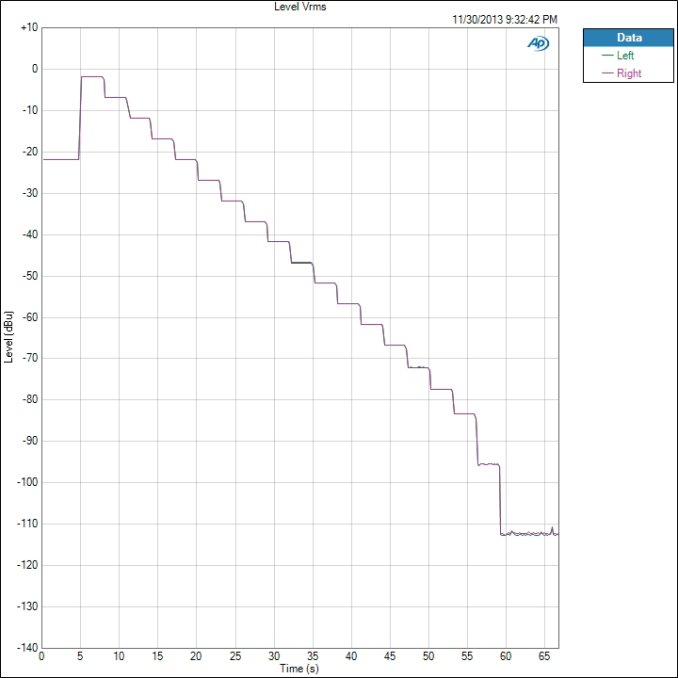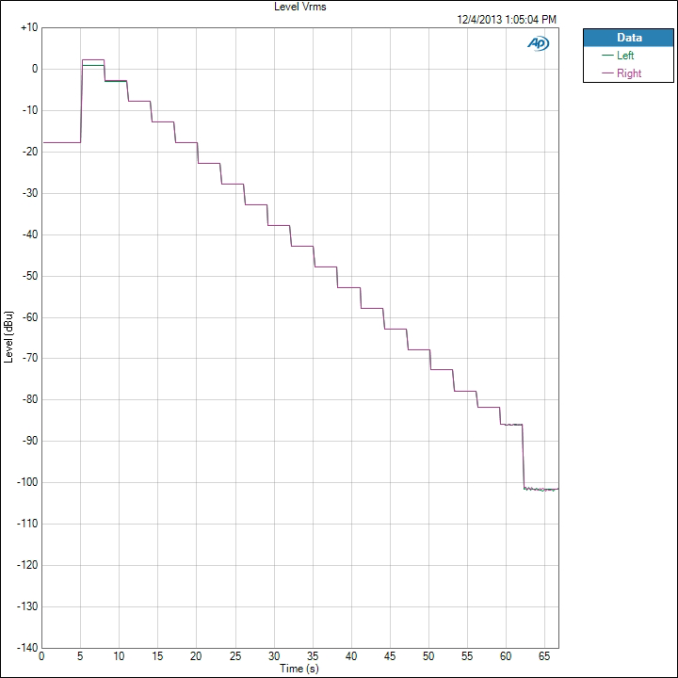Smartphone Audio Quality Testing
by Chris Heinonen on December 8, 2013 5:15 PM EST- Posted in
- Smartphones
- Audio
- Mobile
- Tablets
- Testing
Dynamic Range
The dynamic range of the phone indicates the difference between the loudest possible sound and the background noise. The more residual noise in the background, the lower the dynamic range. Phones with more powerful amplifier sections will typically produce a greater dynamic range. The residual noise level is often constant, so as the overall volume level increases the difference between the music and the noise increases as well.
The best performer here is the iPhone 5 again, with 92.214 dB of range. The worst is the Nexus 5 with only 89.332 dB. A difference of 3 dB is not something I would concern myself over. If we see a phone or tablet that drops down below 80 dB then I will start to show more concern.
Crosstalk
Crosstalk, like dynamic range, is just a number here. This is the measurement how much signal leaks from one channel into another. If an instrument should only be in the right ear, some of that signal will leak into the left ear, but we want that as low as possible. The results are expressed in -dB, or how much quieter one ear is than the intended ear.
On the Note 3 we see a wonderful crosstalk measurement of -117.2 dB so the sounds in one ear are -117 dB quieter in the other ear. This makes them impossible to hear. The worst is the iPhone 5, with only -75.624 dB of isolation.
Stepped Response
The stepped response uses a 1 kHz 0 dBFS tone but measures output level from maximum volume to minimum volume. We can see how large the volume steps are and how many there are. It doesn’t produce a number we can use, but it ties back into our other results. For a good example, we can look at the Note 3.
We see steps that are around -5 dBu each. The final level is muted and just the background noise of the device. Each step is clean and even but as we get lower and lower we see noise start to intrude. This is the background noise starting to become audible in the signal. The flatter the levels are, the quieter it will be. Now, let us look at the Nexus 5.
Notice at the very top how the right and left channels do not overlap. That is the clipping we talked about at the very beginning. It isn’t until the 4th volume setting that the level difference is down to nothing. Because of this, I would consider the top 3 volume settings of the Nexus 5 as ones that should be avoided. They each have enough THD+N introduced into them that it will sound poor, and one ear will be louder than the other.












188 Comments
View All Comments
psuedonymous - Monday, December 9, 2013 - link
Any chance of a test/roundup of bluetooth receivers?Impulses - Monday, December 9, 2013 - link
I'd love to see that.deathdemon89 - Monday, December 9, 2013 - link
I do hope you consider providing the audio tests in the main review on the day it's published, as opposed to tacking it on later. I usually read reviews only once, i.e. on the day they are published and don't keep returning to individual reviews looking for updates, so this would be a major data point readers like me would not be able to take advantage of.DanNeely - Monday, December 9, 2013 - link
I wouldn't hold my breath. Chris H isn't a typical smartphone reviewer. As a result getting these results at initial launch time would require either buying additional sets of test equipment for the reviewers, buying an additional phone for Chris H to do audio testing on, or delaying the article to ship the phone to Chris H after completing the rest of the testing work.Audio precision won't let you see pricing information without creating an account on their website. That suggests it's painfully expensive and that getting multiple copies of the hardware won't happen. Getting multiple copies of the phone isn't cheap either and is probably not going to happen except perhaps for a few halo devices. With the peanut gallery raging about any reviews that don't make it out on release day, I'm doubtful that anandtech would choose to delay reviews for a few days for a specialized test.
Impulses - Monday, December 9, 2013 - link
Ehh, I agree, if it's not realistic to have this testing the day the review is out it's no big deal... If it's a deal breaker for you then you'd wait the same amount of time either way, and if it's not (probably the majority of readers) then there's no point in making the rest wait.xaml - Saturday, December 14, 2013 - link
"Chris H isn't a typical smartphone reviewer. As a result getting these results at initial launch time would require either buying additional sets of test equipment for the reviewers, buying an additional phone for Chris H to do audio testing on, or delaying the article to ship the phone to Chris H after completing the rest of the testing work."Or buying an additional Chris H...
cheinonen - Monday, December 9, 2013 - link
Having this on the day-of is going to be a challenge for a number of reasons.- Brian is in Arizona, and I'm in Oregon. If there is only a single review sample, I have to get it from him.
- As mentioned, the Audio Precision is ridiculously expensive. I think the APx 582 used starts at $19,000 before adding the HDMI, Bluetooth, and Digital modules I use (I need it for receivers as well). Audio Precision is just a few minutes from my house and they've been nice enough to let me come in, test everything there, and endlessly bother their QA people to get this right. However, as I have to come in I have to schedule that, and it takes time.
- That also makes it far easier to do a batch of these at a time than one at a time. If I had at APx at home it would be easier but right now that's not possible.
So we will try to get all the data, as fast as possible, into the system, but day-of is going to be a logistical challenge. I'd rather have it be accurate than be fast.
cheinonen - Thursday, December 12, 2013 - link
OK, I shouldn't say ridiculously expensive. However, the instrument we use costs enough that it's not feasible for us to have them for myself, Anand, Brian, and everyone else that needs one for testing. The Audio Precision gear ranges from $6K to $50K+ depending on what you need and the price still means we can't outfit everyone with one. So testing will happen as fast as possible, but likely won't run with the reviews when they are initially posted.Bobs_Your_Uncle - Monday, December 9, 2013 - link
This audio bench is a tool of truly significant value to anyone hoping to arrive at the best, most fully informed purchasing decision possible. Given the respect & high regard that AT has earned throughout the tech sector, this audio initiative raises the bar for more than smartphone manufacturers alone.Along these lines, does AT have any plans to initiate a similar audio bench for the various motherboard lines that have recently implemented enhanced audio capabilities?
These are very positive steps toward driving advances in fundamental, yet long neglected platform capabilities. However, as improvements in audio reproduction are realized, there will still remain one critical, & seemingly intractable obstacle to overcome; What's it going to take for the recording industry to give up on compression & adopt a regimen of decent mastering.?
It'd be a shame if the only thing audiophile-grade tech revealed was just how badly most studios butcher great music through compression & lousy mastering.
Impulses - Monday, December 9, 2013 - link
I think that battle's beyond Anandtech'srealm, though the more cognizant the average reader/listener is the better.